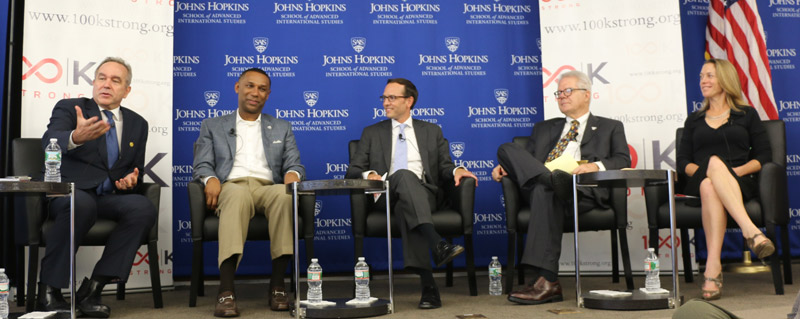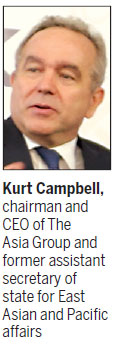100,000 Strong is heralded
Updated: 2014-10-01 10:35
By Chen Weihua in Washington(China Daily USA)
 |
|
From left: Kurt Campbell, chairman and CEO of The Asia Group and former assistant secretary of state for East Asian and Pacific affairs; Johnny Taylor Jr, president and CEO of the Thurgood Marshall College Fund; Evan Medeiros, special assistant to President Barack Obama and senior director for Asian affairs on the National Security Council; David Lampton, professor and director of China Studies at the Johns Hopkins School of Advanced International Studies (SAIS); and Carola McGiffert, president of the 100,000 Strong Foundation, discuss the 100,000 Strong Initiative to send 100,000 American students to China over a period of four years at a meeting at SAIS on Tuesday. The foundation released its latest report of the project's progress at the meeting. [Chen Weihua / China Daily] |
While the China-US relationship has often been described to be the most consequential bilateral relationship in the 21st century, experts agree that student exchange between the two nations will be vital to the future of that relationship.
The message emerged from a panel of scholars, current and former government officials and think tank leaders who met on Tuesday for the debut of a report entitled Strengthening US-China Relations, One Student at a Time - Perspectives from Leaders in the Field.
The report, published by the 100,000 Strong Foundation, features a series of essays by a diverse group of leaders active in US-China relations. While everybody talks about the bilateral relations between China and the US, emphasis has been placed on the 100,000 Strong Initiative, which was announced by US President Barack Obama during his first trip to China in November 2009 to send 100,000 American students to China over a period of four years.
The 100,000 Strong Foundation, set up in January 2013 as a public-private partnership to carry out the mission, declared in July during the 5th annual US-China High-Level Consultation on People-to-People Exchange that Obama's goal of seeing 100,000 Americans study in China had been reached and will be far surpassed by the end of 2014.
Official statistics released last November showed that 68,000 American students had gone to study in China since the initiative was formally launched in 2010.

Kurt Campbell, chairman and CEO of the Asia Group, was regarded as the mastermind behind the initiative when he served as assistant secretary of state for East Asian and Pacific affairs from 2009 to 2013. He said on Tuesday that he found most people who had the opportunity to live and study in China have affection for the country and want to work for the relationship between China and the US.
"They understand some of the basic challenges," he said. "They also dedicate some part of their lives to improving the relationship."
In his essay in the report, Campbell recalled a moment in Beijing in 2012 when both sides showed signs of fatigue and frustration during some tense, high-wire diplomacy where neither party was willing to budge.
"It was at the apex of this tension that we left the negotiation table to attend a meeting of Chinese and American students involved in an educational exchange. As they were introduced, the Chinese students speaking English and the American students speaking Mandarin, one of my Chinese counterparts leaned in and said, 'This is very inspirational. It reminds me of what is possible,'" Campbell said.
"The students' demonstration gave both sides of the table a moment of respite and reflection, leaving us with a renewed sense of optimism that carried the negotiations through to their ultimately successful resolution. These students had also helped remind us of what we were working to protect and build," he said.
David Lampton, professor and director of China studies at SAIS, traced the student exchanges between the two countries since more than a century ago, including his SAIS predecessor Doak Barnett, who was born in Shanghai and later played a major role in the bilateral relationship.
"So we are building the human resources foundation that allows us to take advantage when we get to the high spots in US-China relations, and to navigate around the problems whenever we are going to face as two nations in the low spots," Lampton said.
Data from the Institute of International Education (IIE) last year showed that there were 230,000 Chinese students studying in US colleges and universities. Meanwhile, the number of American students studying in China was estimated at 24,000. While the vast majority of Chinese students are pursuing degree programs in the US, most American students are engaging in short-term programs in China.
The latest IIE report in July showed that among the 73,019 international students pursuing high school education in the US in October 2013, 67 percent were enrolled for a full diploma and most of them were from Asia - with 46 percent of this segment from China.
Noting that Chinese students coming to the US have contributed to the US economy, Lampton said the US is under-investing in this relationship.
"We could do a lot better and we need to do a lot better," he said.
Johnny Taylor Jr, president and CEO of the Thurgood Marshall College Fund, a 100,000 Strong Foundation's signature partner, said this was not about affirmative action, not about civil rights.
"This is smart business," he said.
chenweihua@chinadailyusa.com
(China Daily USA 10/01/2014 page1)